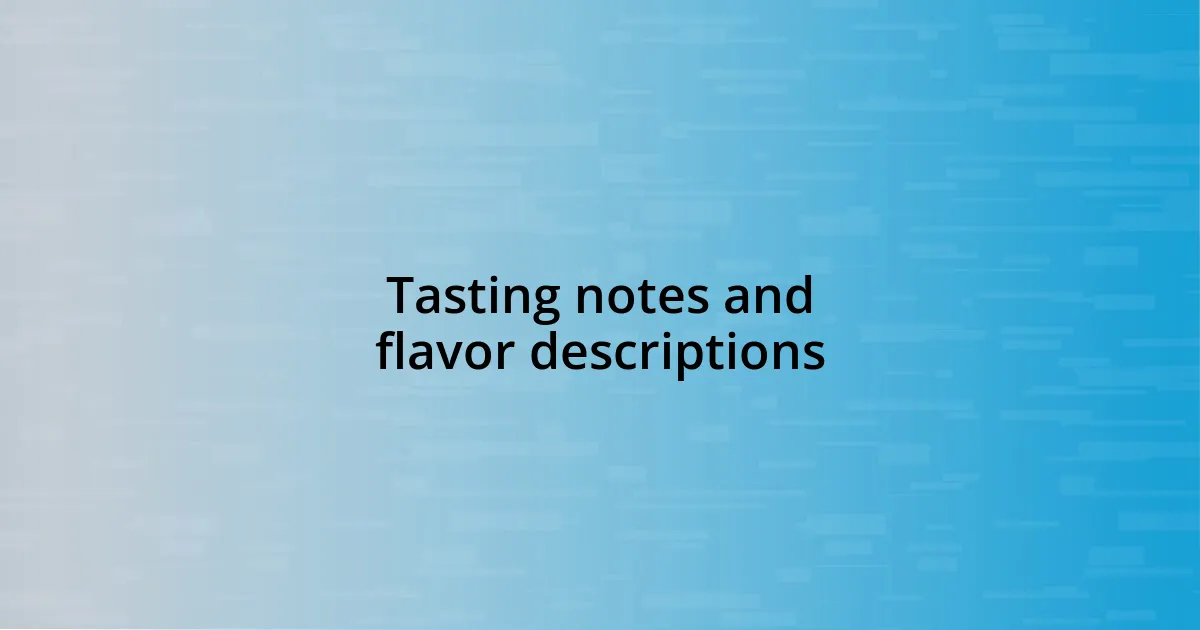Key takeaways:
- Rum flavor profiles are influenced by ingredients, aging processes, and geographical factors, creating diverse tasting experiences.
- Key flavor components include sugarcane sweetness, caramel, fruits, spices, and vanilla, each contributing to the rum’s unique identity.
- Engaging the senses through aroma, taste, and comparative tasting enhances the appreciation of different rums and their cultural contexts.
- Developing a personal rum palate involves reflecting on past experiences, capturing tasting notes, and connecting flavors to specific memories.

Understanding rum flavor profiles
When diving into rum flavor profiles, I often think of the sheer diversity that this spirit offers. Each rum tells a story, shaped by its origin, ingredients, and distillation process. I remember sampling a rich, dark rum from Jamaica that was bursting with notes of molasses and caramel, transporting me to the sun-drenched Caribbean with every sip.
The complexity of rum extends beyond simple tastes; it can evoke emotions and memories, much like a favorite song. Have you ever taken a sip and instantly recalled a warm beach evening or an unforgettable celebration? For me, a particular aged rum brought back nostalgic summer nights spent with friends, its hints of vanilla and oak wrapping around me like a comforting embrace.
When assessing rum, I find it essential to engage the senses fully. The aroma, the mouthfeel, and the finish each play a vital role in the overall experience. I often take a moment to breathe in the subtle complexities, allowing my mind to explore the layered flavors—spicy, sweet, or fruity. How does a hint of cinnamon or a whiff of banana influence your perception? For me, it turns a simple tasting into a rich, immersive experience that captivates all my senses.

Factors influencing rum flavor
When it comes to understanding how flavor profiles evolve, the ingredients used are paramount. The type of sugar cane—whether it’s the rich and robust varieties found in the Caribbean or the lighter types from other regions—can dramatically alter the taste. I once tasted a rum crafted from Fiji sugar cane, and it had a distinct floral note that lingered long after the sip. It struck me that the base ingredient is just the canvas, with the distillation process painting the final picture.
Another crucial element is the aging process. Rums aged in barrels absorb flavors from the wood, leading to complex profiles that can bring out everything from deep vanilla to spicy notes. My experience with a beautifully aged rum from Barbados revealed how the charred barrels infused rich layers of oak and butterscotch, creating a beautifully warm finish. Isn’t it fascinating how time and place interact to shape what we ultimately taste?
Finally, geographical influences shouldn’t be overlooked. The climate and local traditions contribute to the uniqueness of a rum. I remember a tasting in Puerto Rico where the constant humidity was credited with a smoother, sweeter rum that felt different from any I’d had before. The terroir, like in wine, plays a huge role here, proving that environment can be as influential as the distiller’s craft.
| Factor | Influence on Flavor Profile |
|---|---|
| Ingredients | Base sugar cane type affects initial taste and sweetness |
| Aging Process | Barrel type and time influence depth, complexity, and residual flavors |
| Geography | Climate and local methods contribute to distinct characteristics |

Primary flavor components in rum
The primary flavor components in rum are a dance of sweetness, spice, and fruity notes, creating a unique profile that reflects both tradition and innovation. When I take a sip of a well-crafted rum, I’m often greeted with an immediate burst of sugarcane sweetness, intertwined with hints of caramel and vanilla. I once experienced an incredible Haitian rum that showcased bright notes of banana and pineapple, evoking memories of tropical beaches and carefree days. The interplay of these flavors not only delights the palate but also stirs up vivid imagery of the rum’s origin.
Here’s a closer look at some dominant flavor components in rum:
- Sugarcane: The foundation of rum’s sweetness, varying in intensity based on the type used.
- Caramel and Toffee: Common in darker rums, adding depth and richness.
- Fruits: Pineapple, banana, and citrus notes can emerge, depending on regional styles and fermentation.
- Spices: Hints of cinnamon, nutmeg, or allspice often appear, especially in spiced rums.
- Vanilla: Frequently derived from aging barrels, providing warmth and comfort to the overall experience.
It’s fascinating to observe how these primary components manifest differently depending on the rum’s heritage. Each sip can tell a different story, mirroring my own explorations and experiences. For instance, enjoying a light rum from Puerto Rico with a mojito transports me to sun-kissed afternoons, while savoring a rich, dark rum from Guyana might bring to mind cozy evenings by a fire. This dynamic nature of rum flavor can turn any tasting into a personal journey, connecting us to moments in our lives worth remembering.

Techniques for assessing rum flavors
I’ve found that assessing rum flavors often starts with a simple yet effective technique: taking a moment to observe the aroma. Swirling the glass gently allows the spirit to release its notes, and honestly, it’s a sensory experience that prepares your palate. I remember the first time I inhaled the scent of a high-proof rum; the rich, tropical fragrance carried hints of coconut and spices that instantly transported me to a sun-soaked island. Have you ever closed your eyes and felt like you could almost feel the sea breeze? That’s the power of aroma.
Next comes the taste, and this is where I truly immerse myself. I take a small sip, allowing the rum to coat my tongue. Different areas of our taste buds react distinctively, which is fascinating! With one particular rum from Jamaica, I noticed how the initial sweetness exploded into a wave of spiced oak, culminating in a peppery finish. It made me ponder how something so complex could be distilled into a single bottle. The journey of flavors unfolding on my palate often feels like a story—each sip narrating the tale of its origins.
Finally, I often utilize a technique I like to call “comparative tasting.” This means exploring different rums side by side to get a clearer picture of how flavors differ based on distillation methods or aging processes. I once did this with three rums from different Caribbean islands, and what struck me was not just the variety of flavors but how deeply rooted each rum was in its cultural context. Have you ever tasted something that changed the way you view a whole category of spirits? This method has transformed my appreciation for rum, revealing the beauty in its diversity.

Tasting notes and flavor descriptions
When diving into the tasting notes of rum, I often latch onto the distinct aromas wafting through my glass. With one particular aged rum from Barbados, the first sniff brought forth a wave of nostalgia. I caught strong hints of tropical fruits mingled with soft oak—almost like being at a family gathering where mangoes are ripe for picking. Have you ever let a scent take you to a cherished memory? It’s remarkable how deeply intertwined aroma and memory can be.
As I sample, the dance of flavors unfolds on my tongue, revealing layers of complexity. I once tried a spiced rum that first teased my palate with subtle vanilla before erupting into an explosion of warm, baking spices. Each sip felt like a gentle embrace, wrapping me in a cozy blanket as the comforting notes lingered. How can something bottled hold so much warmth and character? It’s these transitions I find utterly fascinating, as they reflect the care and craftsmanship behind each batch.
I also cherish the moments spent sharing my tasting experiences with friends. I remember a lively evening where we compared a light white rum to a robust dark rum. The conversation sparked as we debated the sweeter notes versus the deeper, richer flavors, each perspective adding depth to our understanding. Isn’t it incredible how tasting can become a communal activity that bonds us over simple pleasures? It’s one of the many reasons I love exploring rum, letting each new tasting be an invitation to engage, discuss, and connect with others.

Comparing rum brands and styles
When comparing rum brands and styles, I often find myself caught in a delightful whirlwind of diversity. For example, tasting a premium Cuban rum next to a funky Jamaican version really highlights the stark contrasts in flavor profiles. I recall a session where I was grappling with the smooth elegance of Havana Club, while the lively spices from Appleton Estate danced on my tongue. Isn’t it a revelation how the same spirit can embody such different personalities?
Another fascinating aspect is the impact of aging and barrels on taste. I recently had the opportunity to sample a Solera-aged rum from Venezuela, brimming with toffee and caramel notes. In contrast, a fresh, unaged rum from Puerto Rico showcased bright citrus and grassy notes. The experience made me reflect on how aging in different barrels, such as bourbon or sherry casks, can genuinely shape the storytelling of a rum. Have you ever wondered how time transforms a spirit?
Moreover, the regions where rums are produced carry their own distinct flavors based on local ingredients and traditions. I once enjoyed a rum from the Dominican Republic that was rich with sugarcane sweetness, alongside a complex, earthy rum from Guyana. It struck me how the local soils, climate, and methods of production contribute uniquely to each bottle. Isn’t it thrilling to think that with every sip, you’re experiencing a piece of the island’s culture and heritage? Such comparisons deepen my appreciation and remind me that rum isn’t just a drink; it’s a journey.

Developing a personal rum palate
Developing a personal rum palate is a journey that goes beyond mere tasting. I often reflect on my early experiences when I’d sample rum without much thought, simply enjoying the buzz. As I’ve matured in my appreciation, I’ve learned to savor and dissect each sip—recognizing what I truly enjoy. Have you ever had that moment where a specific flavor just resonates? For me, it was the first time I picked up hints of nutmeg in a spiced rum, igniting a newfound passion for exploring the intricacies of each profile.
Every tasting session serves as a lesson, guiding my palate toward unique distinctions. I still remember my first encounter with an agricole rum from Martinique; it felt like meeting a completely different spirit. The grassy, fresh notes seemed to transport me straight to a sugarcane field. It left me pondering: how can something so raw and vibrant evoke such vivid imagery? This experience taught me to appreciate the origins of each rum, leading me to explore various expressions and distillation methods.
Writing my tasting notes has become an essential part of this growing process. I meticulously jot down my observations, capturing emotions that bubble up with each sip. I recall sipping a rum that reminded me of my grandmother’s holiday baking—full of spice and warmth. It’s these connections that shaped my personal palate and transformed tastings into a deeper exploration of memories. How often do you connect flavors to moments in life? Embracing flavor profiles in this intimate way has enriched not only my understanding of rum but has also woven it into the fabric of my experiences.
















